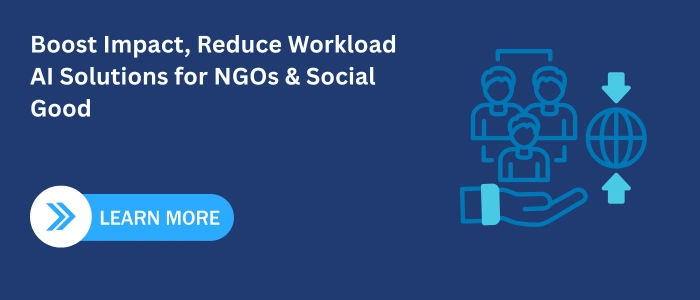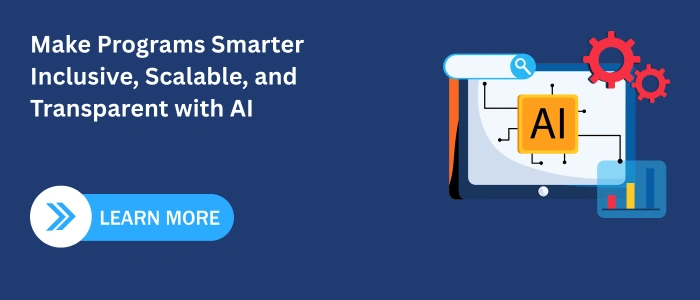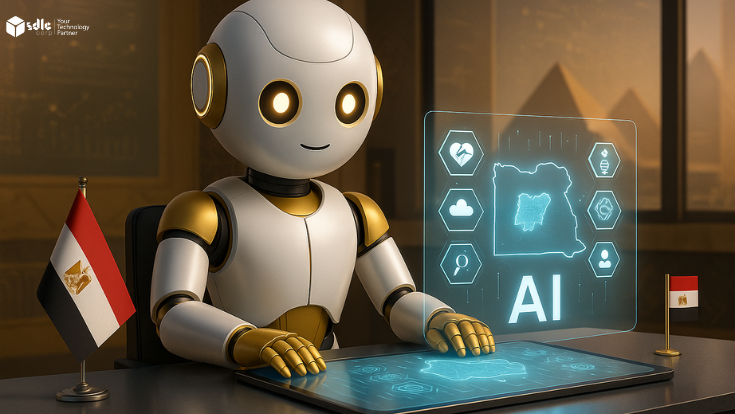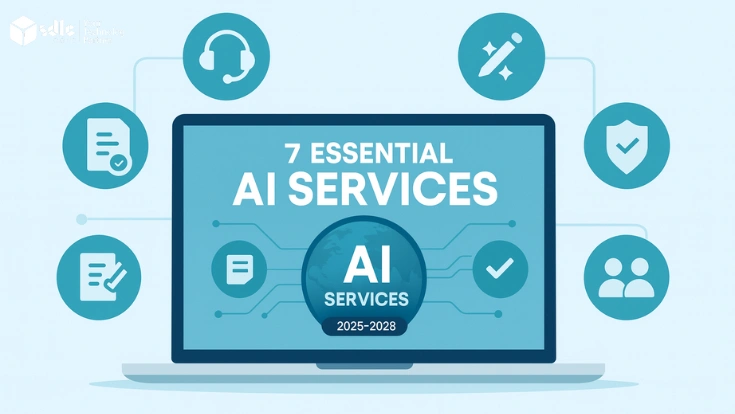Introduction
Social impact organizations operate in environments where resources are scarce, but expectations are high. They must serve diverse communities, safeguard sensitive data, and remain transparent to donors and regulators. All of this has to be achieved with limited budgets and small teams.
Generative AI is transforming this sector by enabling organizations to do more with less. It reduces repetitive tasks, enhances service delivery, and supports inclusivity across multiple languages and formats. Many nonprofits choose to collaborate with an Generative AI development company to design secure, ethical, and mission-driven solutions.
The Rising Role of Generative AI in Social Impact
Generative AI offers nonprofits more than just automation. Unlike traditional tools, it can create, summarize, and translate content, while also providing natural conversational support. This means organizations can rely on AI development services to design systems that draft grant responses, prepare outreach materials, and assist staff with routine information requests, all while keeping workflows simple and manageable.
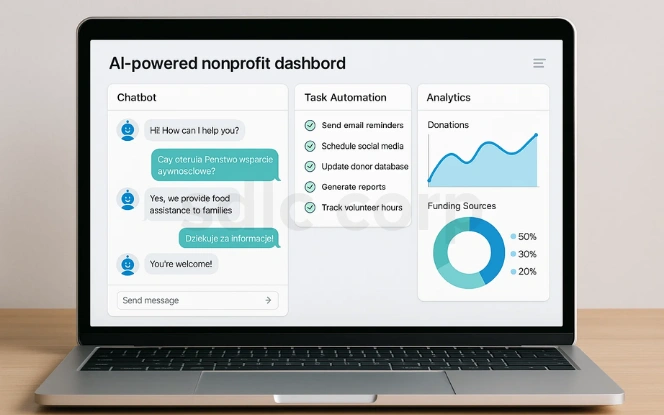
- Respond to beneficiaries faster.
- Reduce administrative burdens on staff.
- Provide services in multiple languages.
- Strengthen donor and beneficiary trust through transparent reporting.
Key Benefits for Nonprofits and NGOs
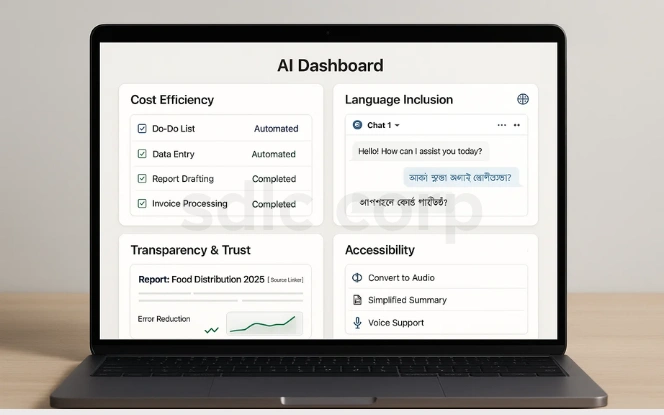
Cost Efficiency
Generative AI helps nonprofits reduce operational strain by automating repetitive tasks and improving productivity.
- Automates tasks like data entry and form filling.
- Drafts reports quickly and accurately.
- Allows staff to focus more on direct community engagement.
Language Inclusion
AI breaks language barriers, enabling nonprofits to reach multilingual and diverse communities effectively.
- Translates documents and resources.
- Supports multilingual chatbots.
- Makes information available in regional dialects.
Transparency and Trust
AI improves credibility by ensuring accurate reporting and consistent communication with donors and stakeholders.
- Creates evidence-linked reports.
- Reduces human errors in data presentation.
- Demonstrates accountability with consistent documentation.
Accessibility
Generative AI ensures inclusivity by providing content in formats accessible to low-literacy and disabled communities.
- Converts documents into simplified or summarized formats.
- Provides audio versions for low-literacy communities.
- Offers voice-enabled support for individuals with disabilities.
Real-World Use Cases of Generative AI
Beneficiary Support
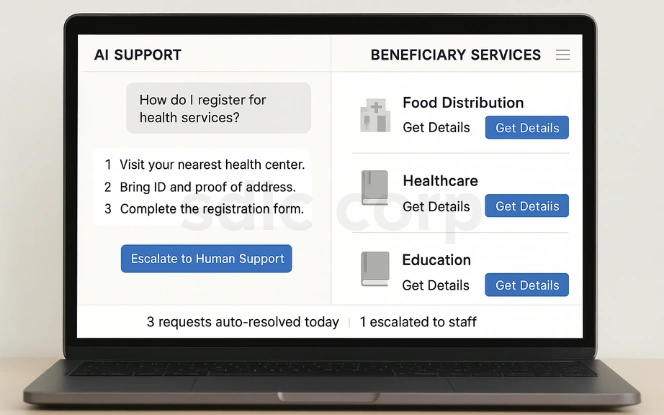
- Instant FAQ responses: AI-powered chatbots can provide quick answers to common questions, reducing long waiting times and improving user experience.
- Service guidance: They can direct beneficiaries to relevant programs like food distribution, healthcare, or education, ensuring faster access to services.
- Human escalation: If a case is too complex, the chatbot automatically routes it to human staff so beneficiaries still receive personalized support.
- Optimized resources: By handling repetitive queries, AI reduces staff workload, allowing teams to focus on urgent or higher-impact activities.
Field Staff Assistance
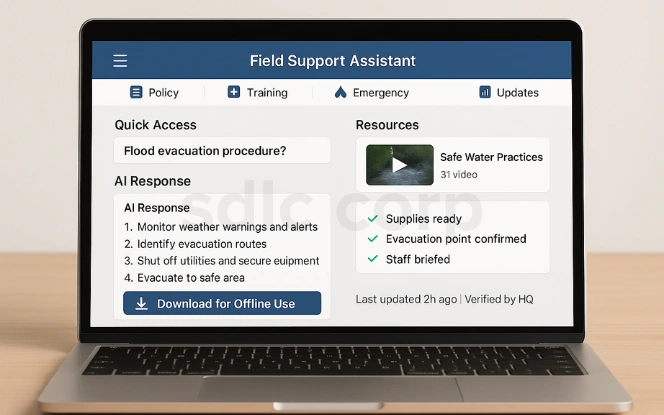
- Quick access to policies: Field workers can instantly look up policy guidelines and procedures, saving time in high-pressure environments.
- On-demand training: AI assistants deliver best practices, training content, or updates whenever required, even in remote locations.
- Crisis support: During emergencies, AI can provide step-by-step instructions, giving staff reliable guidance when they need it most.
- Better decisions: With real-time information, staff can make accurate and timely decisions, reducing errors in critical moments.
Reporting and Evaluation
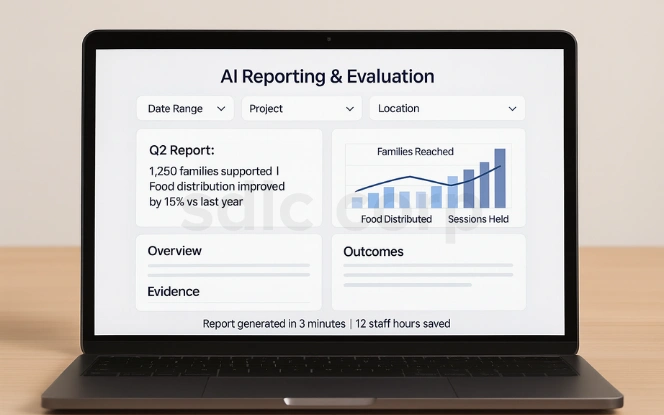
- Automated summaries: AI can summarize lengthy reports, transcripts, and field data into concise, easy-to-read outputs.
- Accurate analysis: It helps analyze program results consistently, giving organizations reliable insights for decision-making.
- Structured reporting: Donor and stakeholder reports can be generated in a clear, professional format with evidence included.
- Time savings: Automating reporting saves hours of manual work, freeing staff to focus on serving communities directly.
Accessibility and Education
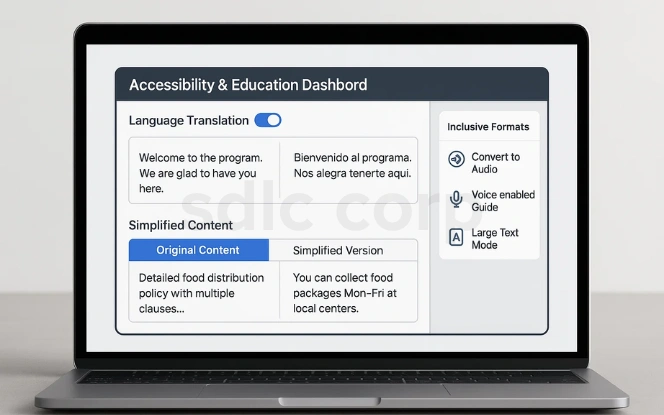
- Language translation: AI translates important resources into local languages, making them understandable for diverse communities.
- Simplified content: Complex information can be turned into shorter, easier summaries for low-literacy users.
- Inclusive formats: AI creates accessible options like audio versions or voice-enabled guides, ensuring people with disabilities can benefit equally.
Challenges in Adoption
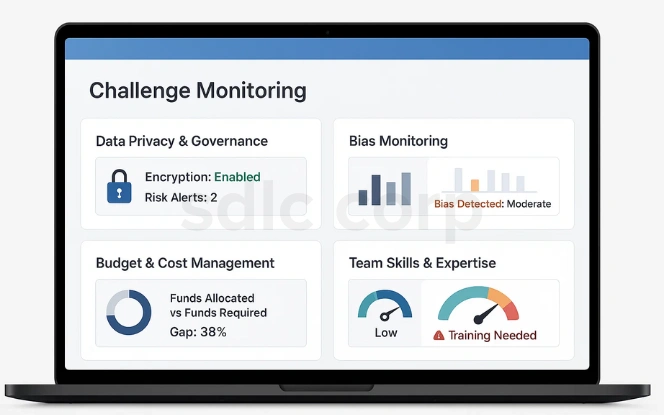
Even though generative AI holds great promise, nonprofits often face hurdles when trying to adopt it. Some of the most common challenges include:
- Data privacy concerns: Beneficiary data is highly sensitive and requires strict encryption and governance.
- Bias and fairness: Without monitoring, AI may replicate hidden biases in data, leading to unfair outputs.
- Budget limitations: AI adoption requires funds for infrastructure, APIs, or cloud usage.
- Limited in-house expertise: Most nonprofit teams lack AI specialists, making it harder to manage projects responsibly.
How Social Impact Organizations Can Get Started
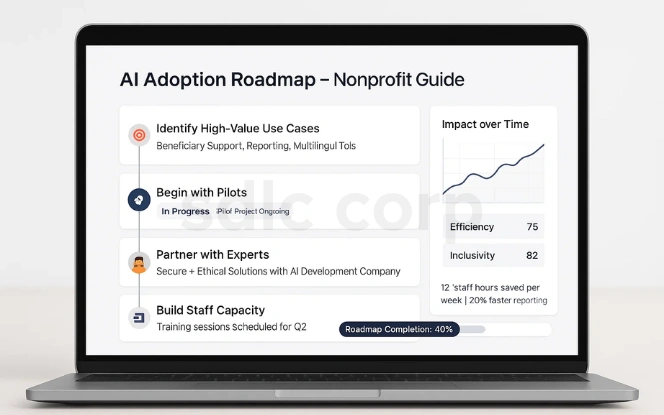
1. Identify High-Value Use Cases
Start by targeting areas where AI can deliver measurable improvements.
Beneficiary support
Donor reporting
Multilingual communication
2. Begin with Pilots
Test AI adoption on a small scale before committing fully.
Launch small-scale pilot projects
- Gather feedback from staff and communities
Refine tools before scaling
3. Partner with Experts
Work with specialists to build secure and ethical solutions.
Collaborate with an AI development company
Ensure solutions are secure, ethical, and tailored
Reduce risks and maximize benefits
4. Build Staff Capacity
Equip teams with the knowledge to use AI responsibly.
Train staff to use AI tools effectively
Integrate AI responsibly into daily workflows
5. Measure Impact
Evaluate results with clear performance and inclusivity metrics.
Track staff hours saved
Monitor reporting accuracy
Evaluate accessibility improvements
Technical Considerations for Generative AI in Nonprofits
Data Protection & Compliance
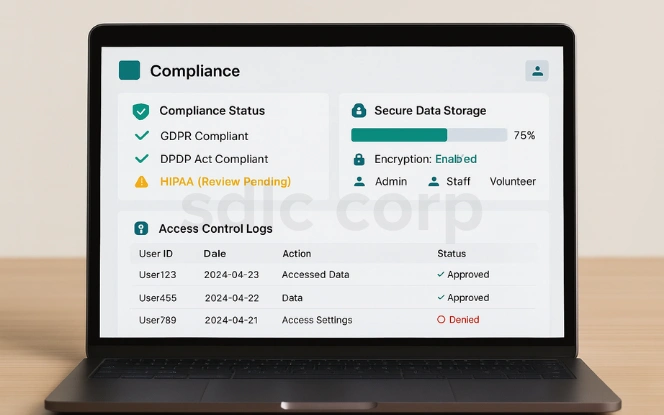
Nonprofits must protect sensitive beneficiary and donor data with strong security. Following regulations like DPDP Act and GDPR ensures compliance and trust.
- Follow regulations like India’s DPDP Act and EU GDPR.
- Use secure data storage with encryption and strict access control.
Responsible AI Practices
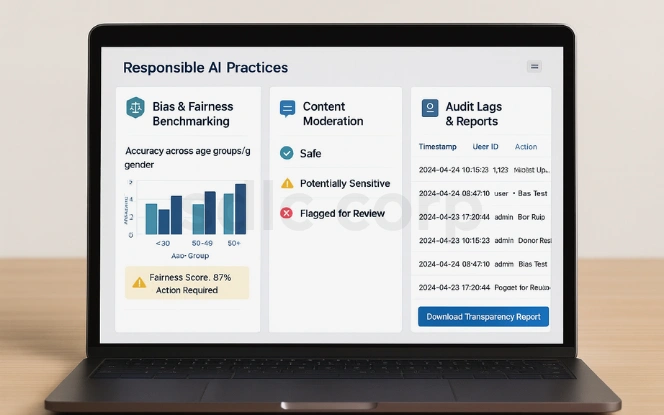
Nonprofits should ensure fairness and safety in AI systems by testing for bias, adding moderation layers, and maintaining audit logs for transparency. In practice, teams often rely on Generative AI consulting services to review model behaviour, assess risk areas, and define controls before systems go live.
Test for bias using recognised fairness benchmarks and representative data sets.
Add moderation layers to filter harmful or misleading outputs before they reach users.
Keep audit logs and transparency reports to support internal reviews and maintain donor trust.
Technology Stack (Lightweight & Affordable)
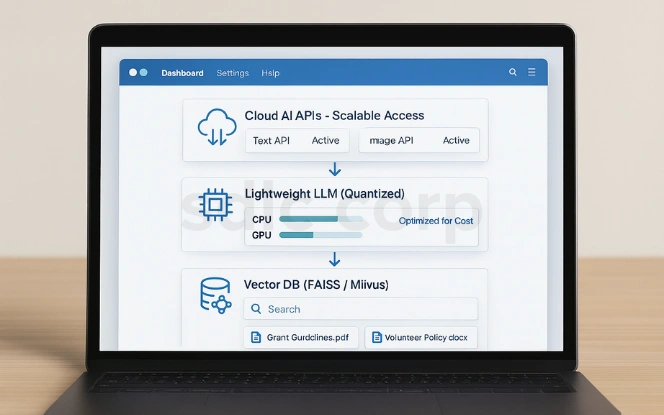
Nonprofits can adopt AI cost-effectively by using cloud-based APIs, optimized open-source LLMs, and vector databases like FAISS or Milvus for accurate retrieval.
- Use cloud-based AI APIs for scalability.
- Leverage open-source LLMs with quantization (runs on lower hardware).
- Store documents in vector databases (FAISS, Milvus) for accurate knowledge retrieval.
Evaluation Metrics
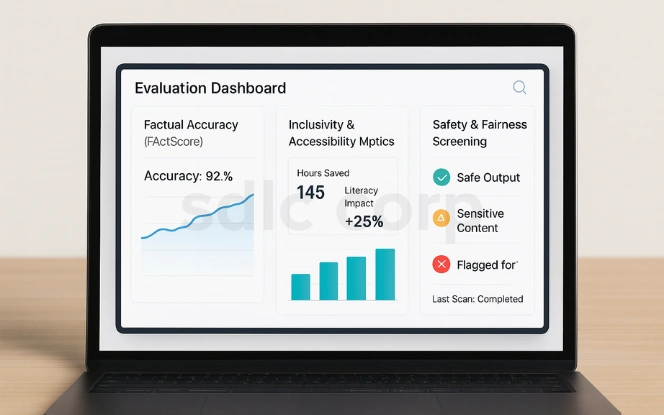
AI adoption should be measured through factual accuracy, inclusivity, and safety checks, ensuring solutions improve efficiency without compromising fairness.
- Check factual accuracy with tools like FActScore.
- Measure inclusivity and accessibility (hours saved, literacy impact).
- Screen outputs for safety and fairness before deployment.
Future Outlook

Generative AI is more than a tool; it’s a way to amplify human effort. For nonprofits, its future lies in:
- Delivering personalized services at scale.
- Expanding access to underserved populations.
- Building stronger trust with stakeholders through transparency.
Conclusion
Generative AI is already transforming how nonprofits deliver services, manage resources, and connect with communities. From providing instant beneficiary support to streamlining donor reporting, it offers practical solutions to long-standing challenges.
But responsible adoption requires both technical expertise and ethical safeguards. This is why many organizations choose to hire generative AI developers who understand the balance between technology and human needs. With skilled developers and proper governance, generative AI can move from being just a tool to becoming a trusted ally in creating lasting social change.
Related Blogs You Should Explore:
FAQ's
How Can Generative Ai Help Nonprofits?
It helps nonprofits cut down repetitive work, translate resources, improve accessibility, and generate accurate, evidence-based reports.
Why Is Ai Important For Social Impact Organizations?
AI enables nonprofits to stretch limited resources further, serve more beneficiaries, and maintain transparency.
What Are The Key Benefits Of Generative Ai In Ngos?
Lower operating costs, multilingual support, better accessibility, and stronger donor reporting.
What Challenges Do Nonprofits Face In Adopting Ai?
Data privacy, bias in outputs, high costs, and lack of technical expertise.
How Should Nonprofits Begin Using Ai?
Start with pilot projects, partner with an AI development company, train staff, and measure outcomes.
Can Generative Ai Improve Accessibility For Vulnerable Communities?
Yes. Nonprofits use AI to create simplified content, generate audio resources, and enable voice-based support.
Why Should Nonprofits Hire Ai Developers?
To ensure solutions are technically reliable, ethically designed, and tailored to nonprofit goals. Skilled developers balance technology with mission needs.

